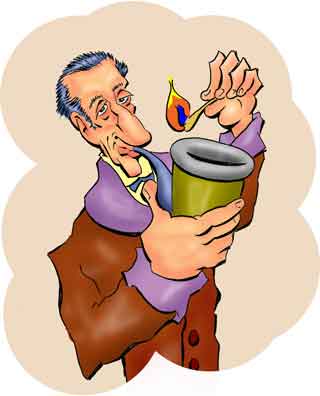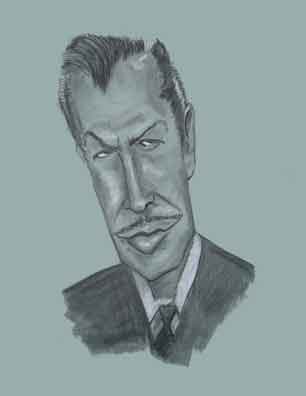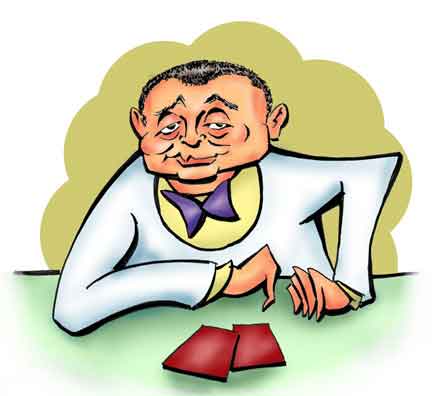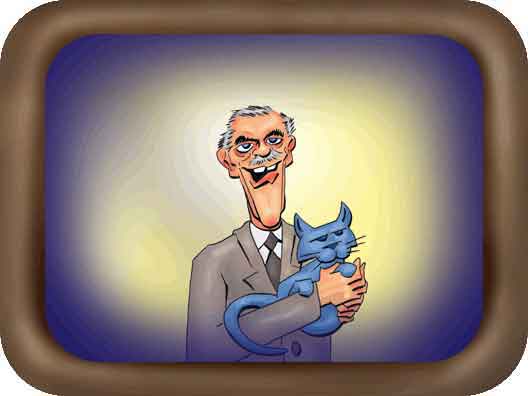Basil Rathbone
The Model for the Rest

Basil Rathbone
A Role Model ...
Although from a reasonable well set up family, Basil Rathbone didn't attend University1. But after completing his secondary education he knew he wanted to be an actor. After all this was the era - Basil was born in 1892 - when professional stage actors were in high demand. If you wanted to see drama, comedy, or musicals, it had to be live drama, comedy, or musicals.
We also have to be honest and point out that Basil had a leg-up over his thespian competitors. His cousin, Frank Benson, was a successful actor and theater manager and was knighted by King George V. Frank - who looked a lot like Basil - gave his cousin a tryout and found the young man had what it takes.
Basil started acting in 1911 when he appeared in Shakespeare's The Taming of the Shrew. So he had only been acting for three years when World War I hit2. He was given a lieutenant's commission - he was, after all, of the genteel middle class. He saw combat, and he liked to tell the story of how he once gained military information from the Germans by disguising himself as a tree.
Footnote
A lot of Americans don't realize that the United States did not enter the Great War of 1914 until 1917 although Winston Churchill, as First Lord of the Admiralty, had been doing his darnedest to pull America into it. But Woodrow Wilson, who had been elected President on a promise to keep America out of the War, knew popular opinion was to stay out.
Then in January 1917, the German Foreign Minister, Arthur Zimmermann, sent a message to the German representative in Mexico, Heinrich von Eckardt. Arthur told Heinrich to tell Mexican President Venustiano Carranza that if Mexico joined Germany's side, Germany would make sure that Mexico got back all the land in the American Southwest the gringos had taken in the previous century. The British intercepted the message and handed it over to the US government, who immediately released the details to the press.
Americans went into spittle-flinging diatribes against the Germans, and Woodrow now found American sentiment had reversed 180 degrees. On April 2, 1917, he asked for a declaration of war, and Congress on April 6 granted it. So America was "over there" about a year and a half.

... with Vincent ...
After the war, Basil returned to acting where he appeared in a number of Shakespeare productions at Stratford-on-Avon3. However, he was not yet a major player and was not making big bucks.
Stage actors then (as now) would literally travel around the world to find parts, and in 1923 Basil sailed to New York to perform on Broadway. Many of the plays, though, are no longer part of the modern repertoire, but at least they kept Basil employed.

... Peter ...
But lurking over the horizon was a new form of entertainment that was a boon for some actors and a bust for others. That was the motion picture. By the time Basil came to New York, attending silent films had already become one of the world's most popular pastimes. Economics played no little part in what was truly a phenomenon. Managing a cinema was far less expensive than a live theater, and despite the lack of sound, the lower admission fees were soon packing them in.
In fact Basil had already appeared in a film, Innocent, in 1921 and then acted in a couple of other English pictures before moving to America. But it was his first "talkie", The Last of Mrs. Cheyney, that got the Hollywood moguls interested in this tall and handsome and accented-speaking import from England. Although they found Basil was particularly adapt at playing bad guys who would challenge the good guy to a sword fight, from 1923 to 1939 he played roles as varied as Mr. Murdstone in David Copperfield (1935) to Pontius Pilate in The Last Days of Pompeii (1935) to Baron von Frankenstein in The Son of Frankenstein (1939).
But let's face it. If you're a Basil Rathbone fan, you're a Sherlock Holmes fan. From 1939 to 1946, Basil starred in 14 Sherlock Holmes films with Nigel Bruce co-starring as Dr. Watson. Also beginning in 1939, the dynamic duo played their parts on radio, and these half-hour programs stretched on until 1950 and more than 200 episodes.

... Boris ...
By the standards of today's multi-hour plot-bloated cinematic productions, Basil's Sherlock Holmes films were short, only running 60 to 85 minutes. That seems a rather low return for the paying customers but remember that the typical ticket price of the time was about a quarter - even then quite a bargain. Matinees might even be just a dime and kids younger than five would often get in for free. Such low prices in the pre-television era meant that whole families could go to the movies once a week and maybe more.
However as the 1950's moved on and became the 1960's, going to the theater for only a little more than an hour seemed kind of chintzy4 and pictures shorter than 90 minutes virtually vanished from the theaters. So it seemed like the Holmes films of Basil Rathbone would fade from the public's collective consciousness.
Footnote
One criticism heard when audiences were leaving the 1999 Disney film Inspector Gadget starring Matthew Broderick was its short running time (78 minutes).

... Lon ...
Instead the films became popular with the teen crowd since the lower running times fit perfectly for late night television movies. These now-defunct television program genre were usually aired after the late night news and commonly featured a mystery or horror picture. They were popular with the kids since on the weekends they could invite friends over and stay up late. Parents also tolerated the shows because they knew where the kids were.
Since the late night movie programs typically ran for an hour and a half and had to include about 12 - 15 minutes of commercials5, the films had to be pared down. But with their shorter duration, the Holmes films had to be edited relatively little and so the plots maintained their coherence and continuity.
Footnote
Yes, believe it or not in the early days of American television, a half hour program would have maybe only four minutes of commercials: one minute at the start of the show, two after about fifteen minutes and then another at the end. Hour shows would usually have over 50 minutes of actual program - compared to perhaps 38-40 minute now - and you didn't have to pay a cable or subscription fee.
Basil's Sherlock Holmes films were shown regularly on television well into the 1980's and only faded when the late night format itself gave way to the multi-back-to-back late night talk shows - and (we must admit it) when black and white shows became objects of scorn and derision to the younger viewers. Fortunately by then the DVD's were available for Basil's fans and some of the movies had even fallen into the public domain and could be viewed at your pleasure from computers and mobile devices.
The Sherlock Holmes films, though, were not above criticism, and the Watson as played by Nigel Bruce was not favored by Adrian Conan Doyle, Sir Arthur's son. Adrian felt that the Watson of the books was a man of undoubted intelligence, courage, and energy. He was not, Adrian said, "the bumbling ass6" of the movies.
Footnote
As this is a family oriented web site, it must be realized that the word "ass" when used in England does not have the connotation as in the American dialect. Instead of a reference to the gluteal anatomy, the use equated the individual with the Equus africanus asinus. The kids in C. S. Lewis's Narnia tales use the word without censure as does Pippin in J. R. R. Tolkien's The Lord of the Rings.

... and Merle.
Not unexpectedly Basil tired of playing the same character in the movies and the curmudgeons say Basil was not playing Holmes in fourteen movies but instead was playing Holmes in one movie fourteen times. So after the fourteenth Holmes movie and the two hundred plus radio programs, Basil decided to move on.
And yet for decades afterwards, anyone who played Sherlock was always compared to Basil Rathbone, be it Ronald Howard7, Peter Cushing, or Jeremy Brett. Part of Basil's appeal was he just looked like Sherlock Holmes: tall, with a frame excessively lean and the hawklike nose. Even today in lists of top actors to play Sherlock Holmes, you'll find Basil at the top.
Footnote
This is Ronald Howard, a British actor of the 1930's to the 1970's, not to be confused with the younger American actor and director, Ron Howard. The British Ronald's father was Leslie Howard who gained fame playing the Scarlet Pimpernel.
From 1954 to 1955 Ronald (known as Wink to his friends) starred in the American television show Sherlock Holmes. The episodes were all thirty minute original scripts, and only one ("The Red Headed League") had its title taken directly from the original story by Sir Arthur Conan Doyle (the rather grisly story, The Adventure of the Engineer's Thumb was recast as The Adventure of the Engineer's Shoe. The Sherlock as played by Wink had more of a sense of humor than either the literary character or his later incarnations on the big or small screen.
Dr. Watson was played by Howard Marion Crawford. Marion's Watson was much closer to the character of the original stories - sharp, energetic, a man of action - and quite the ladies man.
By the mid-1950's it was clear that as great a loss as it has been to modern culture, radio was on its way out as an acting venue. It was also clear that television was not going away. So Basil began to appear in guest spots on this new medium of - quote - "entertainment" - unquote - and his performances ran the gamut from comedy to variety to mystery to horror.
But Basil didn't forsake the silver screen. He had a leading role in one of Humphrey Bogart's last movies, We're No Angels (1955) where Humphrey, Peter Ustinov, and Aldo Ray played inmates of Devil's Island. The picture was actually a comedy although Basil played a bad guy.
In 1962 Basil was cast with the iconic trio of horror actors, Vincent Price, Peter Lorre, and Boris Karloff in Tales of Terror one of the low budget but successful productions of American Internation Pictures directed by Roger Corman. Basil, of course, played a bad guy.
Two years later the four again appeared together in the Comedy of Terrors, even today a quite funny movie. Basil played Mr. Black, the landlord of the local funeral directors played by Vincent Price and Peter Lorre, who when times were slack would furnish their own clients. Basil's character was deliberate self-satire as Mr. Black, when he wasn't badgering Vincent for his past rent, would roam through his house, quoting Shakespeare, and brandishing a sword.
As the years went on, Basil continued to make movies but they were clearly intended for his personal remuneration and entertainment of the popular audience rather than continuing his legacy as one of he 20th centuries best actors. These films included Voyage to the Prehistoric Planet (1965), Dr. Rock and Mr. Roll (1965), The Ghost in the Invisible Bikini (1966), and finally Hillbillys in a Haunted House8 (1967). This latter film also featured the otherwise big name stars John Carradine and Lon Chaney, Jr., as well as it being the film debut of none other than country and western singer Merle Haggard9.
Footnote
Today the "official" plural of "hillbilly" - now seen as a pejorative and derogatory word - is "hillbillies".
Footnote
Merle didn't appear as an actual character. Instead at one point, Jeepers, one of the "hillbillies" (who sports a Confederate Army forage cap) was watching a country music television show and one of the performers was Merle.
Sadly, the same year as this last, masterful and unforgettable film was released (well, at least it was unforgettable), Basil died on July 21, 1967 10.
Footnote
There was one last film released after Basil died. That was Autopsia de un fantasma (1968).
References
Elementary: The Life of Basil Rathbone, David Clayton History Press Limited, 2018.
Basil Rathbone: His Life and His Films, Michael Druxman, A. S. Barnes, Incorporated, 1975, (Reprint: Bear Manor Media, 2011).
Basil Rathbone: Master of Stage and Screen, Marcia Jessen, 2019.
"Basil Rathbone", Internet Movie Data Base.
"The Top 20 Actors To Hhave Played Sherlock Holmes", Internet Movie Data Base.
"The Adventure of the Adam Bomb", The Incredible Schlock Homes: 12 Stories from Bagel Street, Robert L. Fish, Simon and Schuster, 1966, Avon Books (1976).